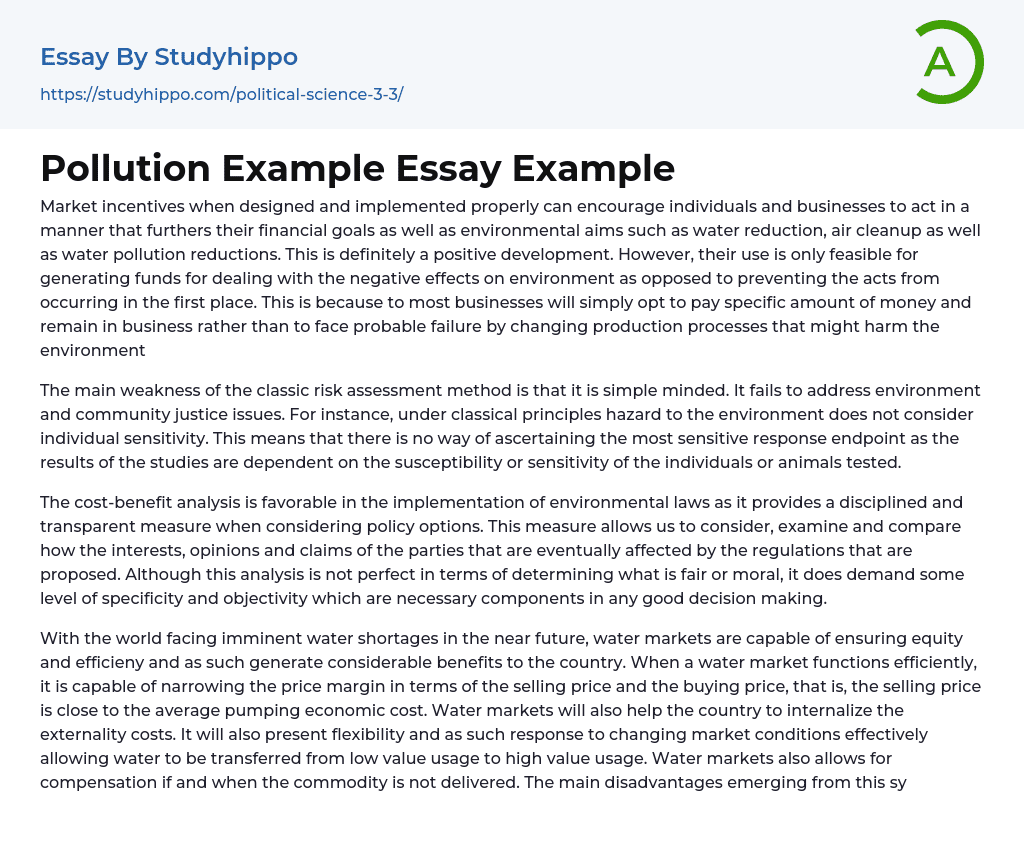Market incentives can effectively encourage individuals and businesses to align their actions with financial goals and environmental objectives. By designing and implementing these incentives, activities such as reducing water consumption, cleaning up air pollution, and mitigating water pollution can be promoted.
Although it is a positive step, this development only focuses on generating funds to address the negative impacts on the environment rather than preventing such actions from occurring in the first place. This is because most businesses prefer paying a fixed amount of money and maintaining their operations instead of making changes to their production processes that could potentially harm the environment. The main flaw of the conventional risk assessment method lies in its simplicity as it fails to consider environmental and community justice concerns. For instance, according to traditional principles, environmental hazards do not take into account
...individual sensitivity. Consequently, determining the most sensitive response endpoint becomes impossible since study results rely on the susceptibility or sensitivity of individuals or animals being tested.
The implementation of environmental laws is favored by cost-benefit analysis as it allows for a disciplined and transparent evaluation of policy options. This analysis enables us to consider, analyze, and compare the interests, opinions, and claims of the parties affected by proposed regulations. While it may not be perfect in determining fairness or morality, it does require specificity and objectivity, which are crucial in decision making processes. Given the impending water shortages, water markets can ensure fairness and efficiency, thereby generating significant benefits for the country. When a water market operates efficiently, it minimizes the gap between selling price and buying price, ensuring that the selling price aligns closely with the average
pumping economic cost.
Water markets have several benefits, such as incorporating the costs that are typically not accounted for, adapting efficiently to market fluctuations, and reallocating water from less valuable to more valuable purposes. Furthermore, they allow for compensations in case of delivery failures. However, the effectiveness of this system depends on factors like physical infrastructure, institutional frameworks, legal structures, and levels of transaction costs.
The United States has implemented water policies using various approaches, including the Clean Water Act, Safe Drinking Water Act, and the EPA Office of Water. The Clean Water Act sets national objectives for water quality and provides permits for waste dischargers in US waters. In 1987, an amendment was introduced to allocate funds specifically for state-run treatment plants. On the other hand, the Safe Drinking Water Act establishes standards to ensure the quality of public drinking water and oversees state efforts to protect groundwater.
An amendment to the act in 1996 mandates local water systems to distribute an annual report with water bills. The Environment Protection Agency also oversees all environmental policies and has influence on water matters. However, the lack of coordination among these policies hinders the effective management of water for the benefit of present and future generations. The fragmentation of various agencies responsible for different water duties can impede water stewardship, routine water management, and drought planning decisions.
Glennon's failure to address how the quantity of free drinking water per household will be determined, along with the impracticality and high cost of separating water mains for different uses, undermines the feasibility of his proposal. Additionally, making excess water usage prohibitively expensive would only exacerbate the problem of water accessibility. The
US water crisis is further compounded by structural issues, such as the expansion of cities in unsuitable locations like Los Angeles, which has led to environmental and wildlife impacts due to dam construction.
The country is facing issues regarding excessive consumption of groundwater, which is causing earth fissures and sinking ground surfaces. This implies that soon the consumption of groundwater will be restricted. While water privatization involves the transfer of water and sanitation services to the private sector, water markets still consider water provision as an essential public service. Under privatization, water prices are determined by market forces, aiming at profitability for companies. On the other hand, water market prices are determined by the costs associated with pumping water to its intended destination. Mary O'Brien's assessment of alternatives states that it is unacceptable to harm individuals when reasonable alternatives are available, including non-human entities. It is not appropriate for one person to define what constitutes acceptable damage for someone else. Additionally, private behaviors often have consequences for the environment and should not be regarded as solely private matters.
- Bottled Water essays
- John Locke essays
- 9/11 essays
- A Good Teacher essays
- A Healthy Diet essays
- A Modest Proposal essays
- A&P essays
- Academic Achievement essays
- Achievement essays
- Achieving goals essays
- Admission essays
- Advantages And Disadvantages Of Internet essays
- Alcoholic drinks essays
- Ammonia essays
- Analytical essays
- Ancient Olympic Games essays
- APA essays
- Arabian Peninsula essays
- Argument essays
- Argumentative essays
- Art essays
- Atlantic Ocean essays
- Auto-ethnography essays
- Autobiography essays
- Ballad essays
- Batman essays
- Binge Eating essays
- Black Power Movement essays
- Blogger essays
- Body Mass Index essays
- Book I Want a Wife essays
- Boycott essays
- Breastfeeding essays
- Bulimia Nervosa essays
- Business essays
- Business Process essays
- Canterbury essays
- Carbonate essays
- Catalina de Erauso essays
- Cause and Effect essays
- Cesar Chavez essays
- Character Analysis essays
- Chemical Compound essays
- Chemical Element essays
- Chemical Substance essays
- Cherokee essays
- Cherry essays
- Childhood Obesity essays
- Chlorine essays
- Classification essays




